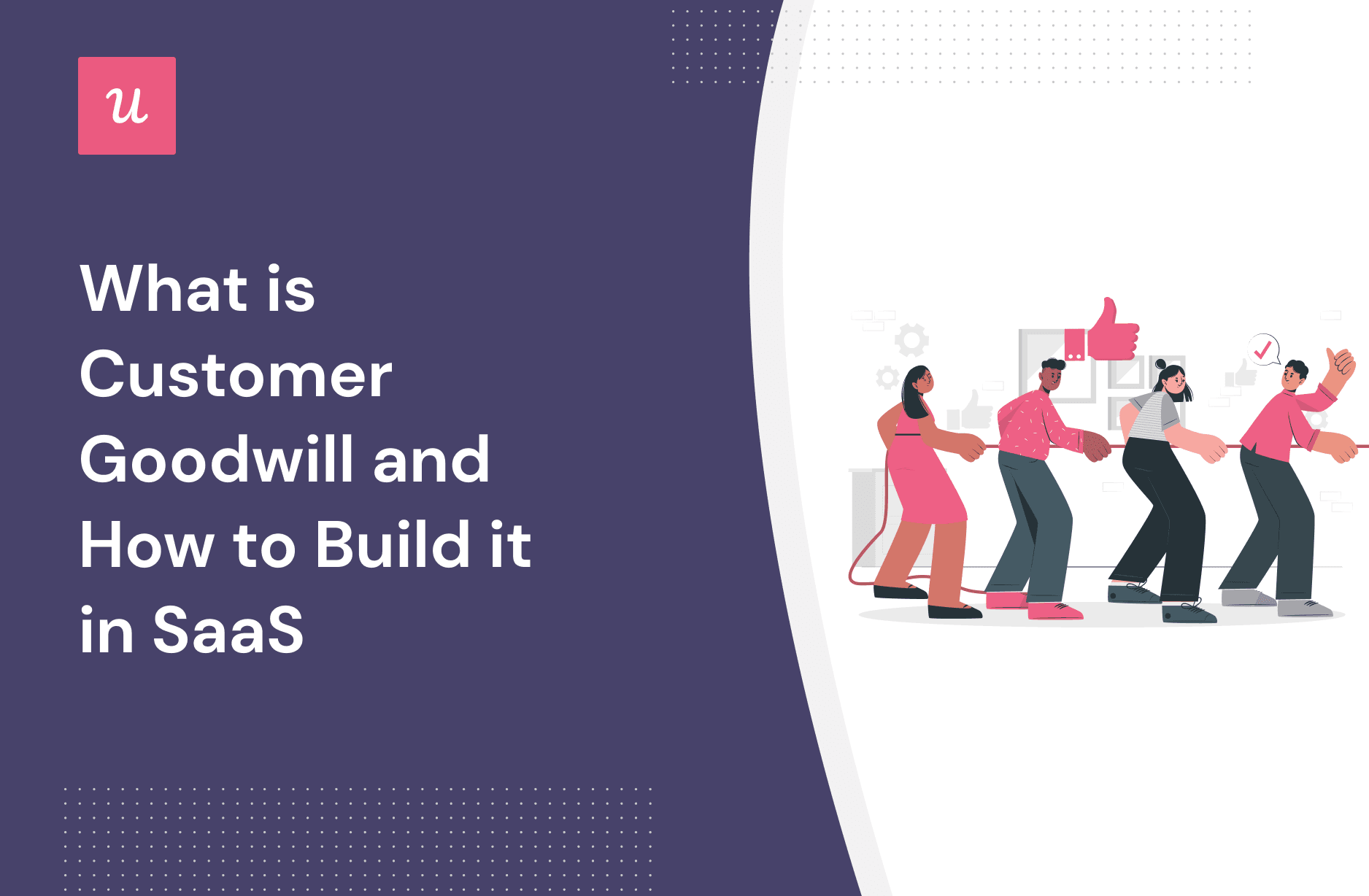
Customer goodwill is a must if you want to:
- Maximize customer success.
- Build rock-solid relationships.
- Retain customers forever.
- Engage users almost permanently.
- Expand word-of-mouth.
But who are goodwill customers exactly? And how are they different from loyal customers?
Let’s dive into the article and explore how you can measure and improve customer goodwill for your SaaS company.
Try Userpilot Now
See Why 1,000+ Teams Choose Userpilot

What is customer goodwill?
Customer goodwill is the positive feeling of alignment and support a customer has for your brand. It’s made up of intangible assets such as brand recognition, customer loyalty, and customer value.
It’s the ultimate stage of your relationship where the customer feels so closely aligned with your brand that they’re happy to purchase anything just to contribute to your business.
Customer goodwill is derived from a customer-centric mentality. Putting the customer at the center of the experience creates an intangible, but strategic return on investment.
Customer goodwill vs. customer loyalty vs. customer satisfaction
First, customer satisfaction is when users are happy with your product’s quality and user experience.
On the other hand, loyal customers are willing to do repeat business with you and choose your brand over your competition (often incentivized with programs and rewards).
But customer loyalty is still not exclusive. They can still switch to a competitor with a better offer.
Goodwill customers, however, are out of reach for competitors. They’re willing to stay with your brand, tolerate problems (as long as you solve them), and contribute to your business whenever and however they can.
How can customer goodwill benefit your business?
Goodwill customers are more profitable than satisfied customers. As they:
- Are willing to share your brand through word-of-mouth.
- Are open to giving honest and transparent feedback and feature ideas.
- Can tolerate problems and obstacles because they trust you.
- Goodwill customers’ LTV is higher as they’re unlikely to switch to a new competitor.
- Advocate for your brand on social platforms and communities.
Now, if customer goodwill is so beneficial, how can you measure and improve it?
How to measure customer goodwill
There’s no single metric that can quantify customer goodwill.
Tracking goodwill is more about collecting insights and cross-referencing multiple satisfaction KPIs to understand the full picture.
Here are a few ways to track it:
Track customer satisfaction score with CSAT surveys
Although customer goodwill and satisfaction are not the same, CSAT surveys are excellent for keeping track of your customer base satisfaction levels and learning how to build good customer relations.
Now, it’s important to use these at every touchpoint of the user journey. This way, you can see how consistent your satisfaction score is across your journey and spot user experience issues.
For example, think of the typical survey you see whenever you use a feature for the first time, interact with support, and so on:

Use NPS surveys to measure customer loyalty
In a nutshell, NPS surveys measure user sentiment by asking, “How likely are you to recommend us to a friend?”. Usually, from a scale of 0 to 10.
Your most loyal customers are those who answer 9 or 10, which is an accurate indicator of how many customers have “goodwill” toward your brand.

Gauge customer goodwill through customer effort score surveys
Effort equals friction. And it directly impacts satisfaction, loyalty, and customer goodwill negatively.
With a customer effort score (CES), you can understand what parts of the user experience and journey are perceived as hard, challenging, or simply annoying—and then improve them.
Here’s an example of a CES survey by Nicereply:

How to build customer goodwill and drive product growth
Customer goodwill must be incentivized and built across every channel and department.
But what can you do from a customer success team?
Here are many ideas:
Define the happy path and keep customers on it with checklists
To ensure success and build goodwill, you must lead users through a series of predetermined steps to achieve their desired result—also known as the happy path.
And once you know your happy path, you can systemize the process by mapping the customer journey, listing each user milestone and touchpoint, plus personalizing the journey for each user persona:

Finally, to incentivize users to take the desired path, implement in-app checklists, so customers don’t get lost and experience friction.
For example, here’s the checklist you see when you sign up for Userpilot for the first time. It highlights the most important actions you need to take and helps you to uncover value fast.

Personalize product experiences and in-app communication
Personalization sets the stage for building a strong relationship and goodwill.
But, you can no longer get away with calling users by their names and expect them to be impressed by that.
A truly personalized product experience delivers customer value according to their specific use case, job to be done (JTBD), and stage in the journey.
You must collect data and segment users based on their needs, in-app behaviors, NPS responses, and product usage.
With segmentation, you can:
- Recommend new features.
- Show in-app guidance when the user is stuck.
- Offer an upgrade when the user has reached their plan limits.
- Send email sequences to support users.
- Trigger in-app experiences according to their in-app behavior.
Plus, there are segmentation tools that make it possible to implement all of this without coding.

Anticipate customer needs and provide proactive customer service
Too much friction will invalidate any goodwill your customer had for you.
To avoid this and increase customer goodwill, you must spot potential issues and address them before they happen.
In short, provide proactive support.
And the best way to offer high-quality customer service is by creating an in-app help center so your customers can access self-service support without leaving your app.
For example, a great help center widget would offer resources such as documentation, video tutorials, FAQs, access to a support agent, and training:

Take customer feedback seriously and act on it
Customer feedback is at the heart of every customer-centric company.
But collecting feedback does nothing if you don’t close the feedback loop.
You see, when you receive feedback, you should act on it and communicate with your customers to make them feel heard—or else it feels like wasted time.
So, for your customer feedback strategy, you can:
- Collect qualitative feedback like in-app surveys, feature feedback surveys, and more.
- Analyze the responses, reach out to users to point out an already existing feature, and make improvements based on it.
- Keep customers on track, and announce when a user-requested feature is now implemented.

Acknowledge and celebrate customer success with variable rewards
Celebrating milestones is a great way to strengthen customer relationships, as it motivates users to engage more with your product as a result of dopamine hits.
With UX gamification, the “gamified” experience results in more customer goodwill and builds relationships through emotional design (think of badges, emojis, animations, etc).
For example, here’s how Calendly celebrates your first scheduled event:

Help customers discover new features and drive repeated value
Users are feature blind. They normally stick to their habits and routines and ignore anything else.
For this reason, it’s a good idea to announce updates regularly, so customers are encouraged to adopt new features and experience repeated value.
You can use a modal to communicate big release notes and major feature announcements. Or an in-app tooltip if you don’t want to be too intrusive.

Similarly, for your mobile app, you can create slideouts with Userpilot for in-app announcements to highlight new features, updates, or time-sensitive promotions.
Nurture long-term relationships with customer loyalty programs
Loyalty programs and rewards help reinforce the emotional connections required to build goodwill.
As a part of your loyalty program, you can offer limited deals, discounts, access to premium features, etc.
For instance, Evernote’s point-based program rewards you with points for inviting friends.
Your friends get premium access when they sign up, and you get points that you can exchange for a premium plan. Impressive, right?

Use UX analytics to identify friction points across the user journey and eliminate them
With UX analytics, you can use methods like heatmaps, usability testing, and session recordings to track:
- How users navigate your product.
- How many times the user clicks on the button.
- How fast do users get to an “Aha!” moment.
- How much time do customers need to complete specific tasks.
Using this data, it becomes relatively easy to spot friction points across the user journey and fix them.
You can also use a customer success tool like Userpilot, for example, to set and track events throughout the user journey to see where your users are struggling:

Use A/B testing to improve the user experience and generate customer goodwill
A better customer experience leads to stronger customer relationships.
So once you’ve implemented everything, use A/B testing to test small changes and see their direct impact on the customer experience. Try:
- Testing new features, welcome page design, happy paths, onboarding flows, and different feedback UI to validate that they lead to the desired outcome.
- Tweaking smaller elements like the choice of button colors or in-app messaging to optimize the product experience.
- Spotting bad UX design to recognize friction points and remove unnecessary steps in a process (like shortening the signup form with SSOs).
For instance, you could test if adding small tooltips could help users find their way around your product’s UI and enhance their first-time user experience.
Additionally, you can use a tool like Userpilot to A/B test in-app experiences with different user segments:

Examples of customer goodwill
Although you can’t truly track customer goodwill with metrics, you can definitely notice when a brand makes a good effort to develop strong relationships.
Userpilot — going the extra mile and exceeding customer expectations
Building goodwill is all about going the extra mile.
One way is by showing appreciation to your most loyal customers by sending them a thoughtful gift that rewards their loyalty.
So we listen to what our customers have to say, do some extra personalizations, and show appreciation to our most loyal customers with thoughtful gifts.
In this case, our team at Userpilot took “listening” too seriously and surprised one of our dream users with a t-shirt after having a call with him.
His reaction? Making it public:

Hubspot — building customer goodwill with customer-centric company culture
Hubspot is known for being customer-centric.
Nobody can escape it, it’s in the company culture and a vital part of their hiring and recruitment process. They not only deliver a robust onboarding experience and self-serve resources for new customers, but some Hubspot users are also assigned a dedicated account manager.
How do they achieve this? Well, the company has a public 10-point “customer code” they use to keep themselves accountable.
Conclusion
Like any relationship, building customer goodwill is complicated.
It doesn’t involve any specific process or tactic to achieve it, as it’s mostly about treating your customers like people.
Thankfully, the good practices we covered in this article will help you improve your current relationships and increase goodwill.
Want to get started with the strategies mentioned above? Book a Userpilot demo and see how our no-code tool can help you with delivering personalized in-app experiences and helping customers get the maximum out of your product.







